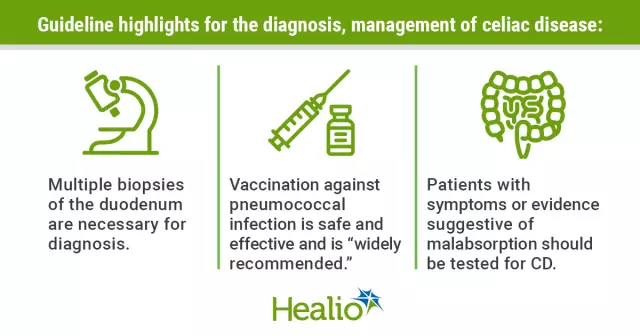- Author Rachel Wainwright [email protected].
- Public 2023-12-15 07:39.
- Last modified 2025-11-02 20:14.
Celiac disease

Celiac disease is a congenital disease in which there is an intolerance to some of the proteins found in cereals. A common misconception is that celiac disease is a new disease that has only emerged in recent decades. This is not so, because celiac disease was first described about a thousand years ago, and then it got its name "Morbus coeliacus". In recent years, thanks to the improvement of diagnostic methods, it has only become clear that the prevalence of celiac disease is much wider than previously thought, and many latent, as well as atypical forms of the disease were previously mistaken for another pathology of the gastrointestinal tract.
Causes of celiac disease
The immediate cause of celiac disease is atrophic inflammation of the villi of the small intestine, which occurs under the influence of some protein fractions that make up cereals and products from them. Such a substance in wheat is gluten (aka gliadin), in oats - avenin, in barley - hordein, in rye - sekalinin. Since wheat and wheat flour products are the most common, celiac disease is also called gluten enteropathy.
Gluten intolerance is congenital. The mechanism of the onset of pathology has not yet been studied, several theories of origin have been put forward, but none of them provides an exhaustive explanation. The most convincing today is the hereditary theory of impaired immunity in celiac disease, since it was found that when examining the parents of children with celiac disease, in many cases latent forms of the disease were revealed.
Celiac Disease Symptoms
Symptoms of celiac disease appear in early childhood when foods containing gluten are introduced into the diet. Most often it is semolina and oatmeal, or infant formula, which contains gluten-containing cereals. Celiac disease manifests itself in children at first as an intestinal disorder. The stool becomes quickened, mushy, profuse, often frothy. The child loses weight, while his stomach enlarges, edema appears. If the disease is not detected at this stage and therapeutic measures are not taken, then calcium absorption is impaired, which leads to the appearance of bone deformities characteristic of rickets. Thus, celiac disease in children is often misleading for parents and pediatricians because the symptoms of celiac disease are similar to those of a number of other diseases. However, it is very important to identify the disease at an early stage,since in the future the symptoms of celiac disease can take on a global nature, manifesting, inter alia, as a lag in physical and mental development.

Celiac disease in adults, if not detected in early childhood, usually has an implicit (latent) nature. The main symptoms of celiac disease in this case are muscle weakness, increased fatigue, perennial pain in muscles and bones, and anemia of unknown origin. Intestinal disorders in adults with celiac disease are not the main symptom, they may not be present, and there may even be a tendency to constipation. However, in some patients, digestive disorders take on a frequent, and sometimes even regular character - frequent loose stools several times a day, containing foam and pieces of undigested food. Celiac disease in adults can be latent, exacerbating under the influence of provoking factors: stress, pregnancy, infectious diseases, and surgical interventions.
Diagnosing celiac disease
Because the symptoms of celiac disease are similar to other disorders of the digestive system, it is very important that in cases of suspicious gastroenterological disorders, a thorough diagnosis is carried out. This is of paramount importance, as it is not difficult to correct celiac disease, but in advanced cases, the disease can lead to many serious complications.
If celiac disease is suspected in children, an immunological blood test (serodiagnosis) is performed for the content of specific antibodies. This analysis is called GSE (Gluten-sensitive enteropathy) - gluten-sensitive tests for enteropathy. Stool is examined for fat and carbohydrate content. In difficult cases, a biopsy of the mucous membrane of the small intestine is necessary.
Celiac disease in adults, due to the lack of symptoms, requires a complete gastroenterological examination, with an immunological study of blood and a biopsy of the small intestine.
One of the most reliable diagnostic methods is comparing the symptoms of celiac disease before and after a gluten-free diet. If the patient's condition improves dramatically when gluten-containing foods are excluded from the diet, the gluten load is applied again. Deterioration of well-being with a gluten load and improvement with a gluten-free diet are the main diagnostic signs of celiac disease.
Celiac disease treatment. Diet
Diet for celiac disease is the main therapy. Without a diet, celiac disease cannot be treated, regardless of medication. The main principle of the diet for celiac disease is the complete elimination of foods containing gluten, even in small quantities.
The basic rules of a gluten-free (gluten-free) diet for celiac disease are as follows:
- Exclusion of products containing gluten: dishes made from wheat, oats, barley, rye and their derivatives in any form;
- Products that cause fermentation processes are excluded;
- Products containing a large number of allergens are excluded;
- Rice, corn, legumes, potatoes are allowed; small quantities of buckwheat are acceptable;
- Meat, eggs, dairy and dairy products, vegetables and fruits are allowed;
- During the period of exacerbation of the disease, the principle of mechanical and chemical sparing is observed, boiled, stewed or steamed food is taken in mashed form.
In young children, the usual infant formula is replaced with a special one based on soy or casein hydrolyzate. Celiac disease in children, when using a gluten-free diet, undergoes a reverse development, children quickly catch up with their peers in psychomotor skills, and subsequently do not differ from them. After the start of strict diet therapy, the symptoms of celiac disease disappear within 3-6 months - this is how long it takes for the atrophied villi of the small intestine to recover. A gluten-free diet must be followed strictly and for life.
Complications of celiac disease

The disease must be treated at any age, whether it be celiac disease in children or celiac disease in adults, since when gluten is introduced, the symptoms of celiac disease increase, gradually leading to a severe disorder of all body systems.
The most common complications are:
- Malignant intestinal tumors;
- Iron-deficiency anemia;
- Ulcers of the jejunum and ileum;
- Infertility, both female and male;
- Avitaminosis and, as a result, a sharp decrease in immunity;
- Decrease in the size of the spleen (hyposplenia), leading to impairment of its functions;
- Hypotension (low blood pressure), resulting in constant weakness, drowsiness, lack of vitality.
YouTube video related to the article:
The information is generalized and provided for informational purposes only. At the first sign of illness, see your doctor. Self-medication is hazardous to health!






